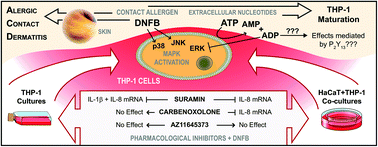Adenosine diphosphate involvement in THP-1 maturation triggered by the contact allergen 1-fluoro-2,4-dinitrobenzene†
Abstract
Dendritic cells’ (DC) activation is considered a key event in the adverse outcome pathway for skin sensitization elicited by covalent binding of chemicals to proteins. The mechanisms underlying DC activation by contact sensitizers are not completely understood. However, several “danger signals” are pointed as relevant effectors. Among these extra-cellular early danger signals, purines may be crucial for the development of xenoinflammation and several reports indicate their involvement in contact allergic reactions. In the present work we used the DC-surrogate monocytic cell line THP-1, cultured alone or co-cultured with the human keratinocyte cell line HaCaT, to explore the contribution of extracellular adenine nucleotides to THP-1 maturation triggered by the extreme contact sensitizer, 1-fluoro-2,4-dinitrobenzene (DNFB). We found that THP-1 maturation induced by DNFB is impaired after purinergic signaling inhibition, and that the transcription of the purinergic metabotropic receptors P2Y2 and P2Y11 is modulated by the sensitizer. We also detected that THP-1 cells only partially hydrolyse extracellular adenosine triphosphate, leading to accumulation of the mono-phosphate derivative, AMP. We detected different and non-overlapping activation patterns of mitogen activated protein kinases by DNFB and extracellular nucleotides. Overall, our results indicate that THP-1 maturation induced by DNFB is strongly modulated by extracellular adenine nucleotides through metabotropic purinergic receptors. This knowledge unveils a molecular toxicity pathway evoked by sensitizers and involved in THP-1 maturation, a DC-surrogate cell line thoroughly used in in vitro tests for the identification of skin allergens.


 Please wait while we load your content...
Please wait while we load your content...